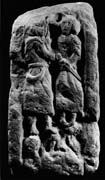Select a site alphabetically from the choices shown in the box below. Alternatively, browse sculptural examples using the Forward/Back buttons.
Chapters for this volume, along with copies of original in-text images, are available here.
Object type: Part of cross-shaft
Measurements: H. 66 cm (26 in); W. 33.1 > 30.5 cm (13 > 12 in); D. 28 cm (11 in)
Stone type: Medium-grained, feldspathic, very pale brown (10YR 7/4) grit; Millstone grit, Namurian, Upper Carboniferous; probably reused Roman ashlar, originally from Hetchell Crag (Thorner) or Otley areas (see Fig. 5)
Plate numbers in printed volume: 216-219
Corpus volume reference: Vol 3 p. 83-84
(There may be more views or larger images available for this item. Click on the thumbnail image to view.)
A (broad): The edge moulding is flat and plain. Within the panel are two standing figures, facing each other in half-profile. The left-hand figure wears a shin-length gown with belt and a hood which also covers the shoulders. A horn hangs at the waist. The right-hand figure wears similar dress with a cloak and wide collar. He carries a short sword on the hip. The detail below their feet is worn and obscure.
B (narrow): A plain, flat moulding survives on the left-hand edge. Within the panel are three medallions of a plant-scroll, with wedge-shaped offshoot leaves on the upper shoulders, and pairs of interlaced round berry bunches within each medallion.
C (broad): Broken and worn.
D (narrow): The plain edge moulding is damaged. Within the panel is and undulating ribbon beast, much worn in its details. It is interlaced in an open mesh of filiform strands.
The plant-scroll and open mesh of face D point to pre-Viking fashions. It is significant that the naturalistic human figures pre-date the common Anglo-Scandinavian taste for secular portraiture; it must have existed in York, perhaps along with secular patronage, before the Viking ingress. The figures are in naturalistic style, and well-modelled. Details of the costume may be taken as accurate contemporary representations. Secular portraiture became a feature of Anglo-Scandinavian monuments in later decades, but only in the county of Yorkshire, not the city of York: for example, in the districts of Otley, West Riding, and Allertonshire and Ryedale, North Riding.
The plant-scroll is a barren, late variety, suggesting a ninth-century date. The taste for enmeshed or bound animals is also a precursor of Anglo-Scandinavian taste: compare the Minster shafts of a generation later (nos. 2–3; Ills. 12–14).
The shaft is significant in demonstrating continuity throughout the transition from Anglian to Anglo-Scandinavian monuments.



